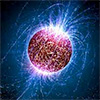| May 18, 2023 |
|
|
|
(Nanowerk News) Upon the cessation of nuclear fusion that characterizes the terminal phase of a star’s life, gravitational forces prevail over the diminished pressure, potentially leading to the emergence of neutron stars – cosmic bodies comprising the universe’s densest matter. The exact composition of these neutron stars, however, has sparked considerable scientific debate.
|
|
A pioneering investigation conducted by a team under the guidance of Professor FAN Yizhong from the Purple Mountain Observatory (PMO) of the Chinese Academy of Sciences (CAS) suggests the probable existence of a strange quark matter core within massive neutron stars, as evidenced by neutron star observations and quantum chromodynamics theory. The examination of this enigmatic core affords a unique opportunity to delve into the equation of state of dense matter and understand the transformation from hadronic to quark matter.
|
|
The study’s findings were published in Science Bulletin (“Plausible presence of new state in neutron stars with masses above 0.98 MTOV“).
|
|
In their analysis, the researchers employed neutron star mass and radius data, gravitational wave information from binary neutron star mergers, and theoretical quantum chromodynamics constraints. Leveraging the comprehensive data and a novel statistical methodology, they conducted an in-depth exploration of the dense matter equation of state’s structure.
|
|
Their investigation uncovered a distinctive peak structure in the sound speed of the equation of state, appearing at a density lower than the core density of the heaviest neutron star. This anomaly implies a deviation from a purely hadronic state.
|
|
Furthermore, they discovered evidence supporting the presence of an exotic core in neutron stars surpassing 0.98 times the mass of the heaviest known neutron star, substantiated by an analysis consistent with both observational data and theoretical stipulations.
|
|
Quantitative analysis suggested that the state at the heaviest neutron star’s center is softer than standard hadronic matter, even when considering the presence of hyperons. The findings thus indicate the plausible existence of a significant exotic core extending over 1 kilometer.
|
